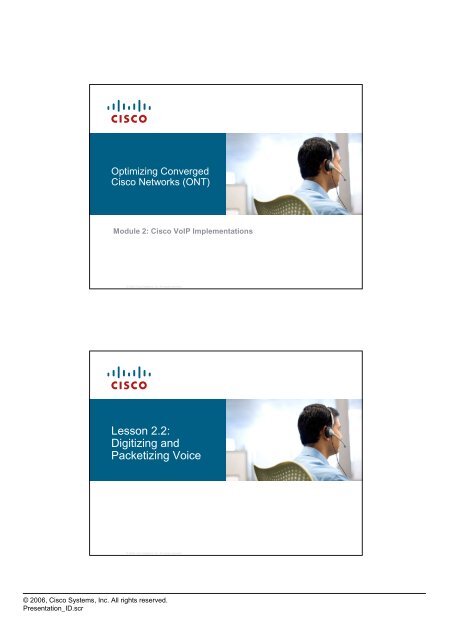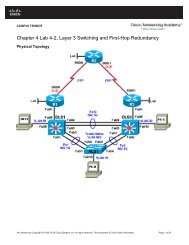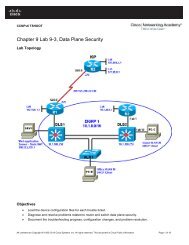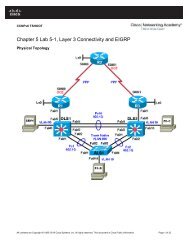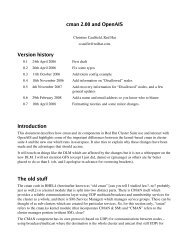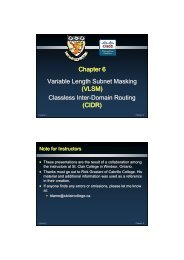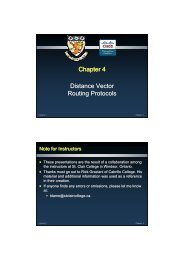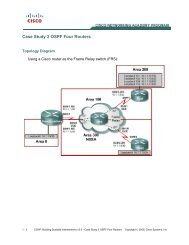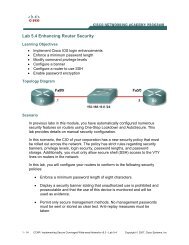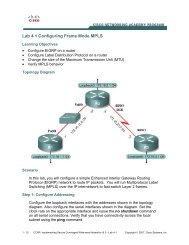Lesson 2.2: Digitizing and Packetizing Voice
Lesson 2.2: Digitizing and Packetizing Voice
Lesson 2.2: Digitizing and Packetizing Voice
You also want an ePaper? Increase the reach of your titles
YUMPU automatically turns print PDFs into web optimized ePapers that Google loves.
Optimizing ConvergedCisco Networks (ONT)Module 2: Cisco VoIP Implementations© 2006 Cisco Systems, Inc. All rights reserved.<strong>Lesson</strong> <strong>2.2</strong>:<strong>Digitizing</strong> <strong>and</strong><strong>Packetizing</strong> <strong>Voice</strong>© 2006 Cisco Systems, Inc. All rights reserved.© 2006, Cisco Systems, Inc. All rights reserved.Presentation_ID.scr
Objectives Describe the process of analog to digital conversion. Describe the process of digital to analog conversion. Explain how sampling rates are determined using theNyquist Theorem. Explain how quantization can lead to noise. Explain how MOS is used to judge voice quality. Describe the purpose of DSPs.© 2006 Cisco Systems, Inc. All rights reserved.Basic <strong>Voice</strong> Encoding: Converting AnalogSignals to Digital Signals Step 1: Sample the analog signal. Step 2: Quantize sample into a binary expression. Step 3: Compress the samples to reduce b<strong>and</strong>width.© 2006 Cisco Systems, Inc. All rights reserved.© 2006, Cisco Systems, Inc. All rights reserved.Presentation_ID.scr
Basic <strong>Voice</strong> Encoding:Converting Digital Signals to Analog Signals Step 1: Decompress the samples. Step 2: Decode the samples into voltage amplitudes, rebuildingthe PAM signal. Step 3: Reconstruct the analog signal from the PAM signals.© 2006 Cisco Systems, Inc. All rights reserved.Determining Sampling Rate with the NyquistTheorem The sampling rate affects the quality of the digitized signal. Applying the Nyquist theorem determines the minimum samplingrate of analog signals. Nyquist theorem requires that the sampling rate has to be at leasttwice the maximum frequency.© 2006 Cisco Systems, Inc. All rights reserved.© 2006, Cisco Systems, Inc. All rights reserved.Presentation_ID.scr
Example: Setting the Correct <strong>Voice</strong> SamplingRate Human speech uses 200–9000 Hz. Human ear can sense 20–20,000 Hz. Traditional telephony systems were designed for300–3400 Hz. Sampling rate for digitizing voice was set to 8000samples per second, allowing frequencies up to 4000Hz.© 2006 Cisco Systems, Inc. All rights reserved.Quantization Quantization is the representation of amplitudes by acertain value (step). A scale with 256 steps is used for quantization. Samples are rounded up or down to the closer step. Rounding introduces inexactness (quantization noise).© 2006 Cisco Systems, Inc. All rights reserved.© 2006, Cisco Systems, Inc. All rights reserved.Presentation_ID.scr
Quantization Techniques Linear quantization:Lower SNR on small signals (worse voice quality)Higher SNR on large signals (better voice quality) Logarithmic quantization provides uniform SNR for allsignals:Provides higher granularity for lower signalsCorresponds to the logarithmic behavior of the human ear© 2006 Cisco Systems, Inc. All rights reserved.Digital <strong>Voice</strong> Encoding Each sample is encoded using eight bits:One polarity bitThree segment bitsFour step bits Required b<strong>and</strong>width for one call is 64 kbps(8000 samples per second, 8 bits each). Circuit-based telephony networks use TDM to combinemultiple 64-kbps channels (DS-0) to a single physicalline.© 2006 Cisco Systems, Inc. All rights reserved.© 2006, Cisco Systems, Inc. All rights reserved.Presentation_ID.scr
Comp<strong>and</strong>ing Comp<strong>and</strong>ing — compressing <strong>and</strong> exp<strong>and</strong>ing There are two methods of comp<strong>and</strong>ing:Mu-law, used in Canada, U.S., <strong>and</strong> JapanA-law, used in other countries Both methods use a quasi-logarithmic scale:Logarithmic segment sizesLinear step sizes (within a segment) Both methods have eight positive <strong>and</strong> eight negativesegments, with 16 steps per segment. An international connection needs to use A-law; mu-to-A conversion is the responsibility of the mu-law country.© 2006 Cisco Systems, Inc. All rights reserved.Coding Pulse Code Modulation (PCM)Digital representation of analog signalSignal is sampled regularly at uniform levelsBasic PCM samples voice 8000 times per secondBasis for the entire telephone system digital hierarchy Adaptive Differential Pulse Code ModulationReplaces PCMTransmits only the difference between one sample <strong>and</strong> the next© 2006 Cisco Systems, Inc. All rights reserved.© 2006, Cisco Systems, Inc. All rights reserved.Presentation_ID.scr
Common <strong>Voice</strong> Codec CharacteristicsITU-TSt<strong>and</strong>ardCodecBit Rate (kbps)G.711 PCM 64G.726 ADPCM 16, 24, 32G.728 LDCELP (Low Delay CELP) 16G.729 CS-ACELP 8G.729ACS-ACELP, but with lesscomputation8© 2006 Cisco Systems, Inc. All rights reserved.Mean Opinion Score© 2006 Cisco Systems, Inc. All rights reserved.© 2006, Cisco Systems, Inc. All rights reserved.Presentation_ID.scr
A Closer Look at a DSPA DSP is a specialized processorused for telephony applications: <strong>Voice</strong> termination:Works as a comp<strong>and</strong>er convertinganalog voice to digital format <strong>and</strong>back againProvides echo cancellation, VAD,CNG, jitter removal, <strong>and</strong> otherbenefits Conferencing: Mixes incomingstreams from multiple parties Transcoding: Translates betweenvoice streams that use different,incompatible codecsDSP Module<strong>Voice</strong> Network Module© 2006 Cisco Systems, Inc. All rights reserved.DSP Used for Conferencing DSPs can be used insingle- or mixed-modeconferences:Mixed mode supportsdifferent codecs.Single mode dem<strong>and</strong>s thatthe same codec to be usedby all participants. Mixed mode has fewerconferences per DSP.© 2006 Cisco Systems, Inc. All rights reserved.© 2006, Cisco Systems, Inc. All rights reserved.Presentation_ID.scr
Example: DSP Used for Transcoding© 2006 Cisco Systems, Inc. All rights reserved.Self Check1. What sampling frequency is recommended by theNyquist Theorem for reconstruction of a signal?2. What is the Hz range for traditional telephonesystems?3. What is the implication of using 8 bits forquantization?4. What is the purpose of logarithmic quantization?5. What is MOS?© 2006 Cisco Systems, Inc. All rights reserved.© 2006, Cisco Systems, Inc. All rights reserved.Presentation_ID.scr
Summary <strong>Voice</strong>-enabled routers convert analog voice signals todigital format for encapsulation in IP packets <strong>and</strong>transport over IP networks. These packets areconverted back to analog at the other end. Quantization is the process of selecting binary values torepresent voltage levels of voice samples. Quantizationerrors arise when too few samples are taken. There are two methods of comp<strong>and</strong>ing: Mu-law, used inCanada, U.S., <strong>and</strong> Japan, <strong>and</strong> A-law, used in othercountries. The Mean Opinion Score (MOS) provides a numericalindication of the perceived quality of received mediaafter compression <strong>and</strong>/or transmission.© 2006 Cisco Systems, Inc. All rights reserved.Q <strong>and</strong> A© 2006 Cisco Systems, Inc. All rights reserved.© 2006, Cisco Systems, Inc. All rights reserved.Presentation_ID.scr
Resources <strong>Voice</strong> Codec B<strong>and</strong>width Calculator (requires CCOlogin)http://tools.cisco.com/Support/VBC/do/CodecCalc1.do DSP Calculatorhttp://www.cisco.com/cgi-bin/Support/DSP/dsp-calc.pl Free VoIP Quality Testerhttp://www.testyourvoip.com/© 2006 Cisco Systems, Inc. All rights reserved.© 2006 Cisco Systems, Inc. All rights reserved.© 2006, Cisco Systems, Inc. All rights reserved.Presentation_ID.scr


